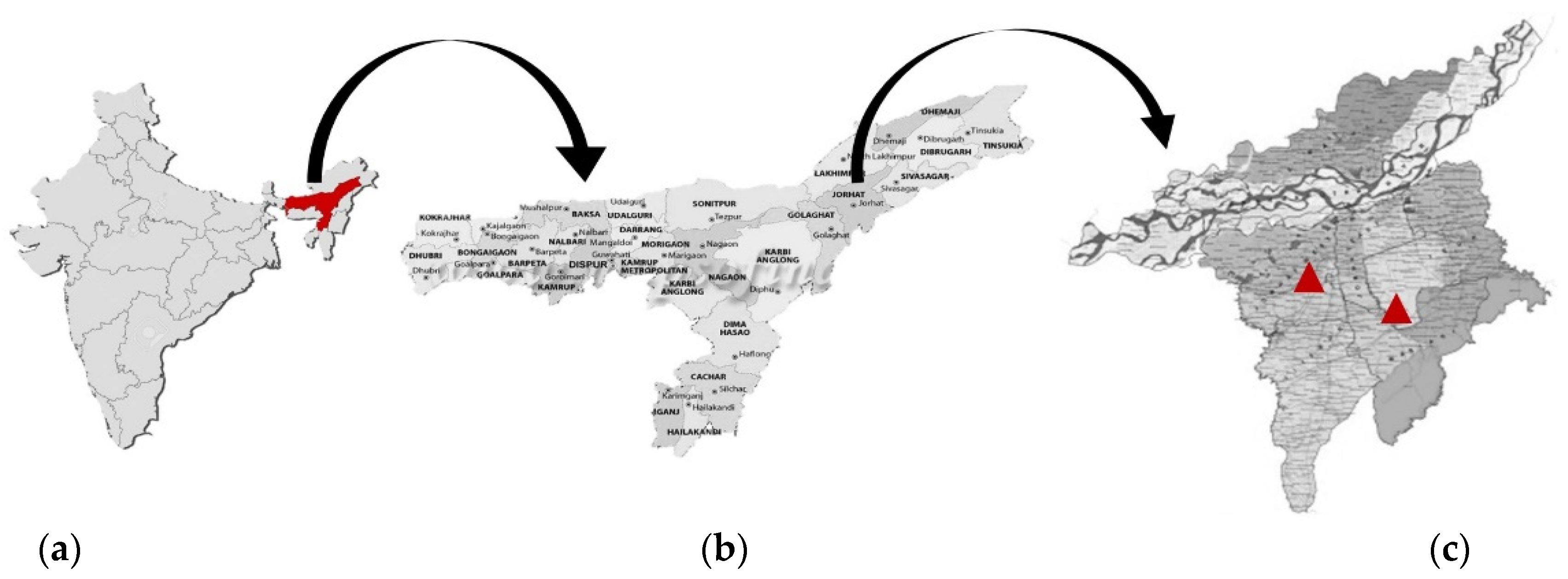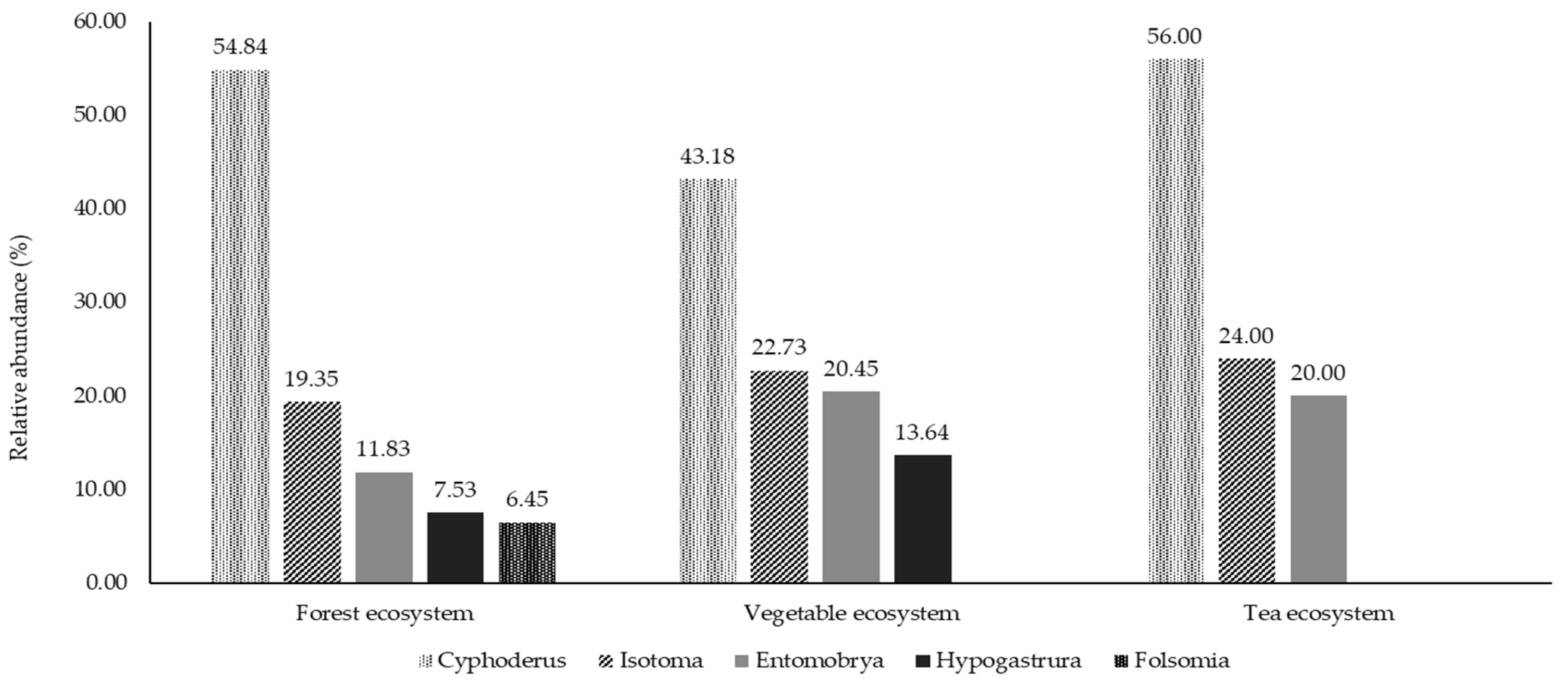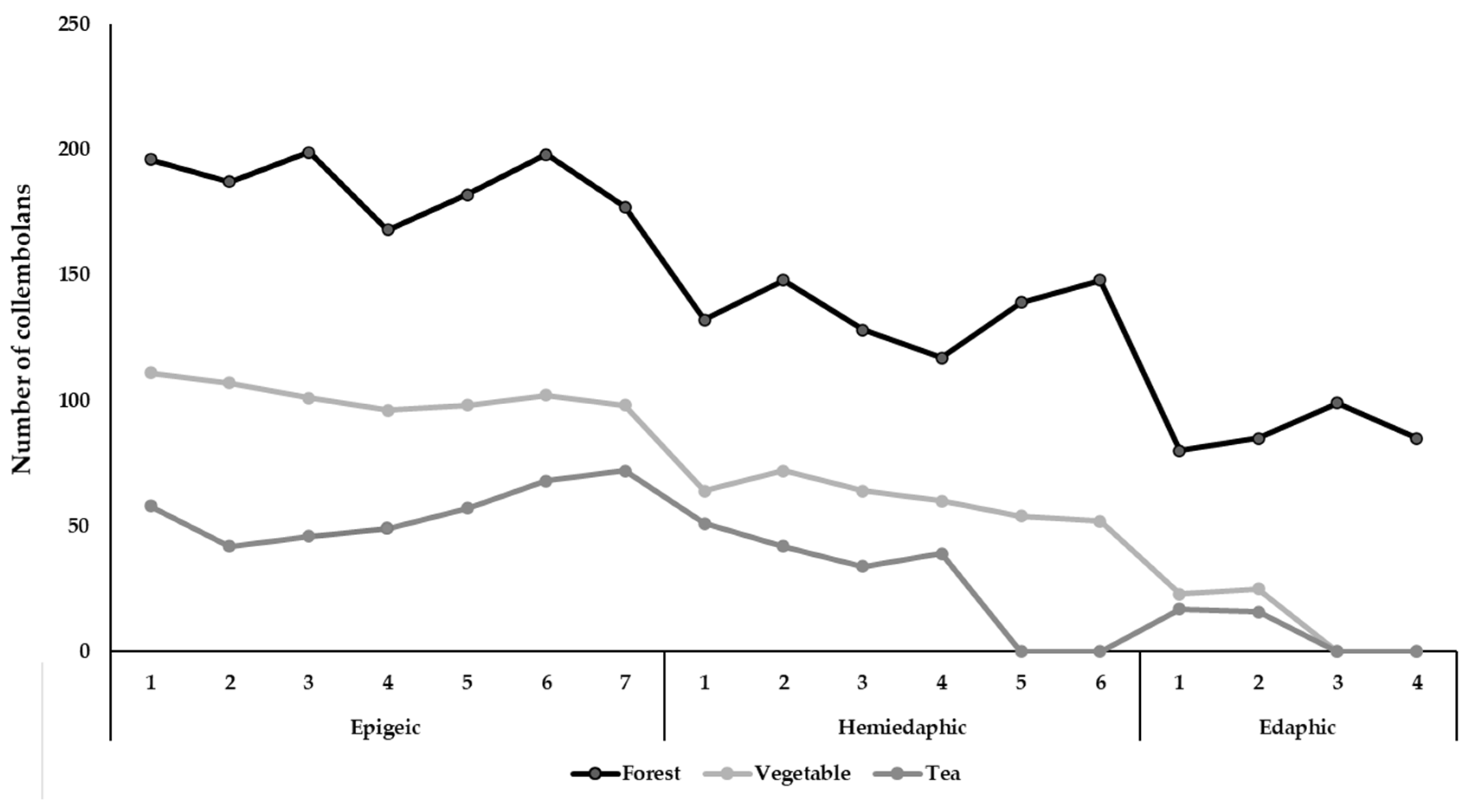Diversity of Soil Dwelling Collembola in a Forest, Vegetable and Tea Ecosystems of Assam, India
Abstract
:1. Introduction
2. Materials and Methods
2.1. Site Description
2.2. Collection of Soil Samples
2.3. Extraction and Identification of Collembolans
2.4. Analysis of Soil Physicochemical Properties
2.5. Statistical Analysis
3. Results
3.1. Species Composition and Relative Abundance
3.2. Seasonal Fluctuation of Collembolan Community Diversity and Density
3.3. Effect of Physicochemical Properties of Forest, Vegetable and Tea Ecosystem Soil on Density and Diversity of Collembola
4. Discussion
5. Conclusions
Author Contributions
Funding
Institutional Review Board Statement
Informed Consent Statement
Data Availability Statement
Acknowledgments
Conflicts of Interest
References
- Bengtsson, J. Disturbance and resilience in soil animal communities. Eur. J. Soil Biol. 2002, 38, 119–125. [Google Scholar] [CrossRef]
- Zeppelini, D.; Bellini, B.C.; Creão-Duarte, A.J.; Hernández, M.I.M. Collembola as bioindicators of restoration in mined sand dunes of North eastern Brazil. Biodivers. Conserv. 2009, 18, 1161–1170. [Google Scholar] [CrossRef]
- Bhagawati, S.; Bhattacharyya, B.; Medhi, B.K.; Bhattacharjee, S.; Mishra, H. Diversity and density of Collembola as influenced by soil physico-chemical properties in fallow land ecosystem of Assam, India. J. Environ. Biol. 2020, 41, 1626–1631. [Google Scholar] [CrossRef]
- Bhagawati, S.; Bhattacharyya, B.; Medhi, B.K.; Bhattacharjee, S.; Mishra, H. Impact of soil physico-chemical properties on the density and diversity of Collembola in Majuli River Island, Assam, India. J. Entomol. Zool. Stud. 2018, 6, 837–842. [Google Scholar]
- Cortet, J.; Ronce, D.; Balaguer, N.P.; Beaufreton, C.; Chabert, A.; Viaux, P.; Fonseca, J.P.C. Impacts of different agricultural practices on the biodiversity of microarthropod communities in arable crop systems. Eur. J. Soil Biol. 2002, 38, 239–244. [Google Scholar] [CrossRef]
- Culik, M.P.; Filho, D.J. Diversity and distribution of Collembola (Arthropoda: Hexapoda) of Brazil. Biodivers. Conserv. 2003, 12, 1119–1143. [Google Scholar] [CrossRef]
- Sousa, J.P.; Bolger, T.; Manuela da Gama, M.; Lukkari, T.; Ponge, J.; Simon, C.; Traser, G.; Vanbergen, A.J.; Brennan, A.; Dubs, F.; et al. Changes in collembola richness and diversity along a gradient of land-use intensity: A pan European study. Pedobiologia 2006, 50, 147–156. [Google Scholar] [CrossRef] [Green Version]
- Filho, L.C.I.O.; Filho, O.K.; Baretta, D.; Tanaka, C.A.S.; Sousa, J.P. Collembola community structure as a tool to assess land use effects on soil quality. Brazilian J. Soil Sci. 2016, 40, 1–18. [Google Scholar] [CrossRef]
- Paul, D.; Nongmaithem, A.; Jha, L.K. Collembolan density and diversity in a forest and an agroecosystem. Open J. Soil Sci. 2011, 1, 54–60. [Google Scholar] [CrossRef] [Green Version]
- Akoijam, R.; Bhattacharyya, B. Standardization of method for soil arthropods extraction by Tullgren funnel. Indian J. Ecol. 2012, 39, 153–155. [Google Scholar]
- Santeshwari, S.; Raghuraman, M.; Singh, J. The preliminary identification characters of some Collembola from Varanasi region of Uttar Pradesh, India. Bioscan 2013, 8, 271–280. [Google Scholar]
- Singh, J.; Mahajan, S.V.; Singh, R.K. Sampling, extraction and precision regarding some statistical studies for population ecology of soil mesofauna. Bull. Entomol. Res. 1978, 19, 130–145. [Google Scholar]
- Jackson, M.L. Soil Chemical Analysis, 1st ed.; Prentice Hall of India. Pvt. Ltd.: New Delhi, India, 1973; p. 498. [Google Scholar]
- Association of Official Analytical Chemists (AOAC). Official Methods of Analysis of AOAC International, 17th ed.; AOAC: Washington, DC, USA, 2000; pp. 785–790. [Google Scholar]
- Chapman, H.D. Cation exchange capacity. In Methods of Soil Chemical Analysis, 2nd ed.; Black, C.A., Ed.; American Society of Agronomy: Wisconsin, IL, USA, 1965; Volume 3, pp. 891–901. [Google Scholar]
- Walkey, A.; Black, I.A. An examination of Degtjareff method for determining soil organic matter and a proposed modification of the chromic acid titration method. Soil Sci. 1934, 37, 29–38. [Google Scholar] [CrossRef]
- Vance, E.D.; Brookes, P.C.; Jenkinson, D.S. An extraction method for measuring soil microbial biomass carbon. Soil Bio. Biochem. 1987, 19, 703–707. [Google Scholar] [CrossRef]
- Clarke, K.R.; Warwick, R.M. Changes in Marine Communities: An Approach to Statistical Analysis and Interpretation, 2nd ed.; PRIMERE: Plymouth, UK, 2001; pp. 243–251. [Google Scholar]
- Simpson, E.H. Measurement of diversity. Nature 1949, 163, 688–691. [Google Scholar] [CrossRef]
- Leinster, T.; Cobbold, C.A. Measuring diversity: The importance of species similarity. Ecology 2012, 93, 477–489. [Google Scholar] [CrossRef] [Green Version]
- Panse, V.S.; Sukhatme, P.V. Statistical Methods for Agricultural Workers, 3rd ed.; ICAR: New Delhi, India, 1985; pp. 353–359. [Google Scholar]
- Wiwatwitaya, D.; Takeda, H. Seasonal changes in soil arthropod abundance in the dry evergreen forest of north-east Thailand with special reference to collembolan communities. Ecol. Res. 2005, 20, 59–70. [Google Scholar] [CrossRef]
- Singh, J. Role of earthworm in sustainable agriculture. In Sustainable Food Systems from Agriculture to Industry, 1st ed.; Galanakis, C.M., Ed.; Academic Press: Cambridge, MA, USA, 2018; Volume 1, pp. 83–122. [Google Scholar]
- Fiera, C.; Ulrich, W.; Popescu, D.; Buchholz, J.; Querner, P.; Bunea, C.; Strauss, P.; Bauer, T.; Kratschmer, S.; Winter, S.; et al. Tillage intensity and herbicide application influence surface active springtail (Collembola) communities in Romanian vineyards. Agric. Ecosyst. Environ. 2020, 300, 107006. [Google Scholar] [CrossRef]
- Tsiafouli, M.A.; Thébault, E.; Sgardelis, S.P.; De Ruiter, P.C.; Van Der Putten, W.H.; Birkhofer, K.; Hemerik, L.; De Vries, F.T.; Bardgett, R.D.; Brady, M.D.; et al. Intensive agriculture reduces soil biodiversity across Europe. Glob. Chang. Biol. 2015, 21, 973–985. [Google Scholar] [CrossRef]
- Harta, I.; Simon, B.; Vinogradov, S.; Winkler, D. Collembola communities and soil conditions in forest plantations established in an intensively managed agricultural area. J. For. Res. 2020. [Google Scholar] [CrossRef]
- Muturi, J.J.; Mbugi, J.P.; Mueke, J.M.; Lagerlóf, J.; Mungatu, J.K.; Nyamasyo, G.; Gikungu, M. Collembola density and diversity along a gradient of land use types in Embu district, Eastern Kenya. Trop. Subtrop. Agroecosystems 2009, 11, 361–369. [Google Scholar]
- Mandal, G.P.; Suman, K.K. Studies on diversity and distribution of soil microarthropods fauna with special reference to Collembola in Sajnekhali Wild Life Sanctuary, South 24 PGS, West Bengal. Rec. Zool. Surv. India 2014, 114, 623–636. [Google Scholar]
- Saikia, A. Occurrence of soil arthropods in different ecosystems of Assam. J. Entomol. Res. 2016, 40, 59–63. [Google Scholar] [CrossRef]
- Liu, Y.; Wang, L.; He, R.; Chen, Y.; Xu, Z.; Tan, B.; Zhang, L.; Xiao, J.; Zhu, P.; Chen, L.; et al. Higher soil fauna abundance accelerates litter carbon release across an alpine forest-tundra ecotone. Sci. Rep. 2019, 9, 10561. [Google Scholar] [CrossRef]
- Abbas, M.J.; Parwez, H. Effect of habitat quality, microclimatic conditions and waste water contamination on diversity and distribution of collembola community. Asian J. Adv. Res. 2020, 4, 35–43. [Google Scholar]
- Holmstrup, M.; Ehlers, B.K.; Slotsbo, S.; Ilieva-Makulec, K.; Sigurdsson, B.D.; Leblans, N.I.W.; Ellers, J.; Berg, M.P. Functional diversity of Collembola is reduced in soils subjected to short- term, but not long- term, geothermal warming. Funct. Ecol. 2018, 32, 1304–1316. [Google Scholar] [CrossRef]
- Ghiglieno, I.; Simonetto, A.; Orlando, F.; Donna, P.; Tonni, M.; Valenti, L.; Gilioli, G. Response of the arthropod community to soil characteristics and management in the Franciacorta Viticultural Area (Lombardy, Italy). Agronomy 2020, 10, 740. [Google Scholar] [CrossRef]
- Santos, M.A.B.; Filho, L.C.I.O.; Pompeo, P.N.; Ortiz, D.C.; Mafra, A.L.; Filho, O.K.; Baretta, D. Morphological diversity of springtails in land use systems. Braz. J. Soil Sci. 2018, 42, 27. [Google Scholar] [CrossRef]
- Hazra, A.K. Ecology of Collembola in a deciduous forest floor of Birbhum district, West Bengal in relation to soil moisture. Orient. Insects. 1978, 12, 265–274. [Google Scholar] [CrossRef]
- Yan, X.; Ni, Z.; Chang, L.; Wang, K.; Wu, D. Soil warming elevates the abundance of Collembola in the Songnen Plain of China. Sustainability 2015, 7, 1161–1171. [Google Scholar] [CrossRef] [Green Version]
- Devi, W.M.; Singh, T.B.; Devi, L.J. Monthly changes of collembolan population under the gradients of moisture, organic carbon and nitrogen contents in a sub-tropical forest soil, Manipur. J. Exp. Sci. 2011, 2, 10–12. [Google Scholar]
- Hazra, A.K.; Choudhuri, D.K. Ecology of subterranean macro and micro arthropod fauna in different degraded and polluted soil environment of West Bengal. Rec. Zool. Surv. India 1990, 120, 281–295. [Google Scholar]
- Hazra, A.K.; Bhattacharyya, B. Studies of Collembola from agricultural fields and waste disposal sites of West Bengal with special reference to their microbial association. Rec. Zool. Surv. India. 2003, 214, 140–142. [Google Scholar]
- Widenfalk, L.A.; Malmstrom, A.; Berg, M.P.; Bengtsson, J. Small-scale Collembola community composition in a pine forest soil—Overdispersion in functional traits indicates the importance of species interactions. Soil Biol. Biochem. 2016, 103, 52–62. [Google Scholar] [CrossRef] [Green Version]





| Genera | Number of Collembola | Accumulative Frequency | Cumulative Frequency |
|---|---|---|---|
| Cyphoderus | 2179 | 52.05 | 52.05 |
| Isotoma | 879 | 21.00 | 73.05 |
| Entomobrya | 644 | 15.38 | 88.43 |
| Hypogastrura | 333 | 7.96 | 96.39 |
| Folsomia | 151 | 3.61 | 100.00 |
| Total | 4186 | 100.00 |
| Ecosystems | Seasonal Density (Number of Collembolans/m2) (Mean ± SD) | |||
|---|---|---|---|---|
| Spring | Summer | Autumn | Winter | |
| Forest | 161.82 ± 20.91 | 340.91 ± 58.17 | 252.73 ± 36.57 | 81.82 ± 17.67 |
| Vegetable ecosystem | 50.91 ± 13.00 | 172.73 ± 30.60 | 125.45 ± 18.08 | 34.55 ± 11.18 |
| Tea ecosystem | 31.82 ± 9.82 | 86.36 ± 19.28 | 62.73 ± 6.71 | 20.00 ± 5.75 |
| S.Ed(±) | 9.37 | 22.54 | 16.41 | 5.48 |
| CD (p < 0.05) | 19.68 | 47.35 | 34.49 | 11.52 |
| Soil Property | Forest Ecosystem | Vegetable Ecosystem | Tea Ecosystem | |||||||||
|---|---|---|---|---|---|---|---|---|---|---|---|---|
| Spr | Sum | Aut | Win | Spr | Sum | Aut | Win | Spr | Sum | Aut | Win | |
| (Mean ± SD) | ||||||||||||
| Den (Nos./ m2) | 161.82 ± 20.9 | 340.91 ± 58.1 | 252.73 ± 36.5 | 81.82 ± 17.6 | 50.91 ± 13.0 | 172.73 ± 30.6 | 125.45 ± 18.08 | 34.55 ± 11.1 | 31.82 ± 9.8 | 86.36 ± 19.2 | 62.73 ± 6.7 | 20.00 ± 5.75 |
| Div (1-D) | 0.65 ± 0.01 | 0.81 ± 0.02 | 0.71 ± 0.01 | 0.60 ± 0.01 | 0.75 ± 0.01 | 0.90 ± 0.01 | 0.87 ± 0.01 | 0.70 ± 0.01 | 0.67 ± 0.01 | 0.85 ± 0.01 | 0.83 ± 0.01 | 0.62 ± 0.01 |
| Sand (%) | 44.2 ± 2.53 | 43.9 ± 2.39 | 44.3 ± 1.77 | 44.2 ± 1.71 | 71.2 ± 1.27 | 70.3 ± 0.71 | 71.7 ± 0.82 | 74.5 ± 0.54 | 55.6 ± 0.48 | 48.1 ± 0.88 | 54.6 ± 0.94 | 51.2 ± 1.10 |
| Silt (%) | 29.3 ± 1.12 | 30.9 ± 1.30 | 30.3 ± 1.12 | 30.4 ± 0.74 | 16.7 ± 0.71 | 16.3 ± 0.51 | 15.4 ± 0.50 | 13.2 ± 0.41 | 32.6 ± 0.70 | 34.7 ± 0.84 | 31.8 ± 0.87 | 30.4 ± 0.49 |
| Clay (%) | 26.5 ± 2.14 | 25.2 ± 1.55 | 25.4 ± 0.77 | 25.4 ± 0.85 | 12.1 ± 0.57 | 13.4 ± 0.61 | 12.9 ± 0.52 | 12.3 ± 0.38 | 11.8 ± 0.45 | 17.2 ± 0.44 | 13.6 ± 0.40 | 18.4 ± 0.31 |
| SM (%) | 33.20 ± 2.33 | 37.11 ± 0.36 | 34.17 ± 1.03 | 31.52 ± 0.67 | 24.22 ± 0.45 | 25.39 ± 0.64 | 24.50 ± 0.38 | 23.58 ± 0.44 | 23.45 ± 0.47 | 27.15 ± 0.56 | 25.65 ± 0.55 | 22.55 ± 0.70 |
| OC (%) | 0.82 ± 0.05 | 0.89 ± 0.03 | 0.85 ± 0.02 | 0.81 ± 0.03 | 0.46 ± 0.02 | 0.53 ± 0.02 | 0.49 ± 0.03 | 0.42 ± 0.02 | 0.33 ± 0.03 | 0.40 ± 0.01 | 0.37 ± 0.04 | 0.31 ± 0.02 |
| SMBC (μg/g) | 154.67 ± 0.40 | 158.18 ± 0.62 | 162.45 ± 0.81 | 157.22 ± 1.35 | 119.41 ± 1.06 | 113.24 ± 0.72 | 117.19 ± 0.88 | 116.73 ± 0.43 | 75.57 ± 0.50 | 78.72 ± 0.72 | 77.28 ± 0.68 | 87.22 ± 0.86 |
| pH (1:2.5) | 5.8 ± 0.09 | 5.9 ± 0.07 | 5.7 ± 0.07 | 5.6 ± 0.07 | 5.4 ± 0.22 | 5.1 ± 0.11 | 5.1 ± 0.11 | 5.3 ± 0.16 | 4.9 ± 0.34 | 4.8 ± 0.29 | 4.8 ± 0.29 | 5.1 ± 0.11 |
| BD (g/cc) | 1.33 ± 0.01 | 1.39 ± 0.02 | 1.35 ± 0.02 | 1.34 ± 0.01 | 1.43 ± 0.01 | 1.38 ± 0.02 | 1.36 ± 0.02 | 1.36 ± 0.02 | 1.44 ± 0.01 | 1.35 ± 0.02 | 1.39 ± 0.02 | 1.32 ± 0.01 |
| Soil Property | Forest Ecosystem | Vegetable Ecosystem | Tea Ecosystem | |||||||||
|---|---|---|---|---|---|---|---|---|---|---|---|---|
| Spr | Sum | Aut | Win | Spr | Sum | Aut | Win | Spr | Sum | Aut | Win | |
| Sand (%) | NS | NS | NS | NS | NS | NS | NS | NS | NS | NS | NS | NS |
| Silt (%) | NS | NS | NS | NS | NS | NS | NS | NS | NS | NS | NS | NS |
| Clay (%) | NS | NS | NS | NS | NS | NS | NS | NS | NS | NS | NS | NS |
| SM (%) | 0.941 ** | 0.821 * | 0.915 * | 0.922 * | 0.914 * | 0.868 * | 0.943 ** | 0.857 * | 0.974 ** | 0.868 ** | 0.852 * | 0.886 * |
| OC (%) | 0.937 ** | 0.962 ** | 0.801 * | 0.965 ** | 0.777 * | 0.856 * | 0.944 ** | 0.967 ** | 0.914 * | 0.923 * | 0.874 * | 0.807 * |
| SMBC (μg/g) | NS | NS | NS | NS | 0.899 * | NS | NS | NS | NS | NS | NS | NS |
| pH (1:2.5) | NS | NS | NS | NS | NS | NS | NS | NS | NS | NS | NS | NS |
| BD (g/cc) | NS | NS | NS | NS | NS | NS | NS | NS | NS | NS | NS | NS |
| Soil Property | Forest Ecosystem | Vegetable Ecosystem | Tea Ecosystem | |||||||||
|---|---|---|---|---|---|---|---|---|---|---|---|---|
| Spr | Sum | Aut | Win | Spr | Sum | Aut | Win | Spr | Sum | Aut | Win | |
| Sand (%) | NS | NS | NS | NS | NS | NS | NS | NS | NS | NS | NS | NS |
| Silt (%) | NS | NS | NS | NS | NS | NS | NS | NS | NS | NS | NS | NS |
| Clay (%) | NS | NS | NS | NS | NS | NS | NS | NS | NS | NS | NS | NS |
| SM (%) | 0.928 ** | 0.890 * | 0.881 * | 0.919 ** | 0.710 * | 0.669 * | 0.752 * | 0.942 ** | 0.923 ** | 0.771 * | 0.773 * | 0.836 * |
| OC (%) | 0.907 ** | 0.921 ** | 0.645 * | 0.964 ** | 0.823 * | 0.873 * | 0.726 * | 0.887 * | 0.823 * | 0.836 * | 0.634 * | 0.903 * |
| SMBC (μg/g) | NS | NS | NS | NS | NS | NS | NS | NS | NS | NS | NS | NS |
| pH (1:2.5) | NS | NS | NS | NS | NS | NS | NS | NS | NS | NS | NS | NS |
| BD (g/cc) | NS | NS | NS | NS | NS | NS | NS | NS | NS | NS | NS | NS |
Publisher’s Note: MDPI stays neutral with regard to jurisdictional claims in published maps and institutional affiliations. |
© 2021 by the authors. Licensee MDPI, Basel, Switzerland. This article is an open access article distributed under the terms and conditions of the Creative Commons Attribution (CC BY) license (https://creativecommons.org/licenses/by/4.0/).
Share and Cite
Bhagawati, S.; Bhattacharyya, B.; Medhi, B.K.; Bhattacharjee, S.; Mishra, H. Diversity of Soil Dwelling Collembola in a Forest, Vegetable and Tea Ecosystems of Assam, India. Sustainability 2021, 13, 12628. https://doi.org/10.3390/su132212628
Bhagawati S, Bhattacharyya B, Medhi BK, Bhattacharjee S, Mishra H. Diversity of Soil Dwelling Collembola in a Forest, Vegetable and Tea Ecosystems of Assam, India. Sustainability. 2021; 13(22):12628. https://doi.org/10.3390/su132212628
Chicago/Turabian StyleBhagawati, Sudhansu, Badal Bhattacharyya, Binoy K. Medhi, Snigdha Bhattacharjee, and Himangshu Mishra. 2021. "Diversity of Soil Dwelling Collembola in a Forest, Vegetable and Tea Ecosystems of Assam, India" Sustainability 13, no. 22: 12628. https://doi.org/10.3390/su132212628
APA StyleBhagawati, S., Bhattacharyya, B., Medhi, B. K., Bhattacharjee, S., & Mishra, H. (2021). Diversity of Soil Dwelling Collembola in a Forest, Vegetable and Tea Ecosystems of Assam, India. Sustainability, 13(22), 12628. https://doi.org/10.3390/su132212628






